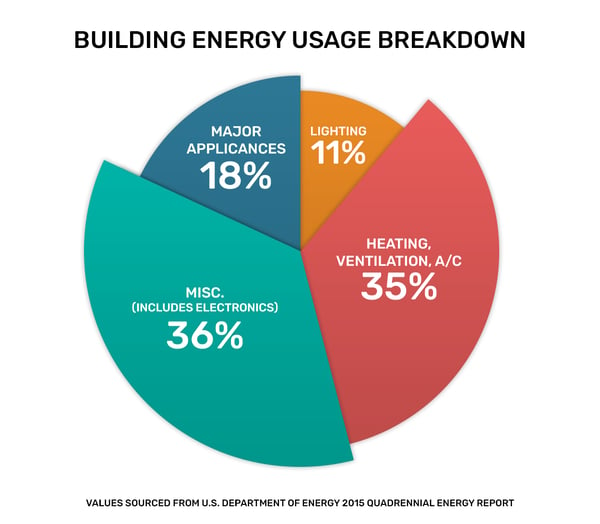I have a Nest in my house, why can’t I have one in my building?
The Nest is a smart thermostat designed to optimize itself based on its users lifestyles.

Efforts to decarbonize the economy have gained rapid adoption in recent years. While energy and transportation tend to get the most coverage, the U.S. building sector consumes 40% of primary energy usage and generates a corresponding percentage of greenhouse gas emissions. Owners who invest in smart, efficiency-focused solutions can significantly reduce their carbon footprints and energy-related costs.
But there is also another reason to go green: energy efficiency can add value to investments and attract tenants. According to the Institute of Business and Economic Research, green buildings command higher rents and enjoy better occupancy rates than traditional buildings.
A notable boon for the adoption of green technology in buildings is that most of the solutions are already on site. Intelligent controls can utilize the data generated by existing building systems to decarbonize buildings and protect the environment. By taking a closer look at the logistics and potential gains of smart control implementation, you can determine if this innovative strategy could be the way forward for your portfolio.
Many commercial real estate investors are surprised by the emission reductions they can achieve through optimization patterns alone. While new developments in material sciences are pushing the thermal and optical properties of treatments for exterior surfaces like windows and roofs, a more immediate path to reducing energy usage is likely to already exist within your building.
Moreover, the adoption of this extant model has the advantage of being quicker to integrate and without the interruptions to day-to-day business that may come with surface treatments or other extensive renovations.
Intelligent control systems operate by unifying data streams already present in your building and providing users with a simple yet powerful tool to access their data. An integrated building management system can handle internal and external data entries to construct a reactive model of emission reduction. The key here is reactivity: an automated BMS relies on an intelligent framework to guide decision-making.
Let’s dive a bit deeper into the weeds.
With smart controls, you can mold your system’s response to shifting needs. Consider lighting and heating elements that are set on timers; these are starting points for a more intelligent approach to BMS, but they lack finesse. Energy efficiency needs a more comprehensive approach than simple time-of-day. Picture an empty building space that is being cooled to a preset temperature. If the space is unused, that energy is being wasted. But if the space suddenly fills with people, it may not be cooled enough. In other words, a time-based cooling model simultaneously does too much and too little, and the failure to factor in human activity overlooks the most essential driver of usage patterns.

Note that a near-majority of building energy usage belongs to heating, ventilation, and A/C usage; decarbonization efforts must incorporate their usage patterns to see significant energy savings. Simply stated, a BMS that does not account for human activity misses vital opportunities to decarbonize buildings.
Understanding usage patterns is key to decarbonizing buildings. Consider that electronics can operate in a binary sense (think a light being turned on or off) or across multiple states of load draw (e.g., a light bulb with a dimmer switch).
Binary |
Multistate |
| System state easily controllable | Multitude of system states allows for a high degree of optimization |
| Energy optimization only involves togging | Binary conditions provide more concrete control options |
CombinedControl operates on two levels to allow greater customization |
|
Imagine a common building situation: a light bulb left on in an unoccupied space. A single bulb draws minimal energy, but energy use can add up quickly when multiplied across multiple fixtures and rooms. The obvious solution is to install motion-detecting sensors to determine occupancy.
Adding sensors to your BMS and allowing sensor data to guide lighting functionality makes a building far more efficient than it once was. But you can take efficiency even further by adding other technologies. For example, dimmer switches allow you to adjust the luminous intensity of lights by reducing the voltage level seen by the load. This in turn reduces energy consumption further.
The value of light dimmers is that they allow you to account for changing ambient lighting. When combined with occupancy-based controls, you gain an even more comprehensive level of efficiency. Now, lighting can first be automated according to occupancy, then modulated based on the amount of daylight in a given area. An intelligent building management platform can capitalize on the data streams of multiple sensors and facilitate their communication. Additionally, alerts can be set up to notify building operators when electronics are drawing energy but not in use or stuck in high usage modes to provide an extra level of system redundancy. The ability to share and coordinate between sensors that would otherwise be isolated from each other is a powerful method to decarbonize buildings.
The key to a robust, intelligent BMS is the overall fitness of the system. With each new sensor, you have access to an additional data stream that can interlace with other systems. Handling this amount of data is no small task. You need a platform that provides instant feedback presented in a quick-digestible format.
onPoint is an innovative cloud-based IBMP that offers user-friendly visualizations to help you understand your building and make better, efficiency-focused decisions. Moreover, proactive analytics look for wear and failures in your system before they occur. Predictive models that optimize repair and maintenance timelines minimize unplanned downtime and increase operational efficiency by making downtime an occurrence you can schedule around.
With the need to decarbonize buildings rapidly mounting, look to onPoint to provide a powerful control overlay that unifies your building systems in a simple-to-use format.

Jason draws on his experience in IT, lighting controls and integrated building management systems to write about commercial real estate industry trends and Buildings IOT customer success.

Motel 6’s “We’ll leave the light on for you” slogan spoke to the hospitality of the brand, but it...